8 Worst Lawn Weeds in Atlanta, GA (and How to Get Rid of Them)
BY MELANIE JOSEPH | JUNE 18TH, 2019 | ATLANTA, GEORGIA, LAWN CAREIn the bustling city of Atlanta, homeowners and gardeners alike are constantly battling against a common enemy: weeds. From the stubborn dandelion to the invasive yellow nutsedge, these pesky plants can quickly overtake green lawns and colorful gardens, causing frustration and headaches for those who take pride in their outdoor spaces.
But which weeds are the worst offenders in Atlanta? And, more importantly, how can they be eradicated for good? Take a closer look at the eight worst lawn weeds in Atlanta and discover expert tips on how you can get rid of them once and for all.
In this article, we will cover:
- Why Are Weeds Bad for Your Atlanta Lawn?
- Ways to Control Weeds in Your Atlanta Lawn
- 8 Worst Weeds in Atlanta
- FAQ About the Worst Weeds in Atlanta
Why are Weeds Bad for Your Atlanta Lawn?
Weeds are the bane of any lawn enthusiast because they look unsightly and cause a whole host of problems. In Atlanta, where the weather can be hot and humid, weeds can quickly take over if left unchecked. Weeds are bad for your Atlanta lawn because they:
- Steal nutrients
- Crowd out your grass
- Attract pests
- Reduce curb appeal
- Are hard to control
Ways to Control Weeds in Your Atlanta Lawn
While it can be daunting to get rid of weeds in your lawn, there are two primary methods of doing so – by hand or with herbicides. Both have pros and cons, and which method you choose will depend on your preferences and the severity of the weed problem in your lawn.
Hand Weeding
Getting rid of weeds by hand is a more natural method and doesn’t involve the use of chemicals. Remove unwanted weeds on a weekly or bi-weekly basis and follow these tips:
- Eradicate them in their early stage – before they flower or establish intricate root structures.
- Remove the entire weed, including its roots, tubers, bulbs, or rhizomes.
- For weeds that have a taproot, like dandelions, you can use a dandelion fork or screwdriver.
Weed Control Chemical Treatments
Herbicides designed to kill weeds are often more effective than hand weeding and can save you time and effort:
- Pre-emergent herbicides: Applied to the soil before the weeds germinate to prevent their growth
- Post-emergent herbicides: Used to control weeds that have already grown
- Systemic herbicides: Absorbed and travel through the entire plant, killing it from the roots up
- Contact herbicides: These kill only the part of the plant they come into contact with
- Soil sterilants: Sterilize the soil, preventing any plant growth
- Broadleaf herbicides: Used for targeting broadleaf weeds while leaving grasses and other plants unharmed
- Iron-based herbicides: These herbicides use iron as the active ingredient
8 Worst Weeds in Atlanta
1. Annual Bluegrass (Poa annua)
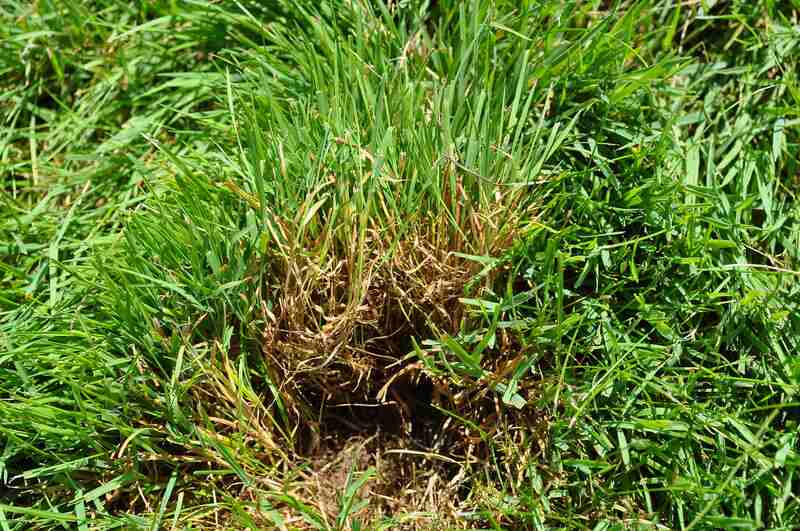
Photo Credit: NY State IPM Program at Cornell University / Wikimedia Commons / CC BY 2.0
One of the worst and most common weeds that plague homeowners and gardeners in Atlanta, annual bluegrass is notoriously difficult to control and can quickly take over lawns and gardens if left unchecked.
Identifying annual bluegrass can be tricky, as it can often be mistaken for desirable grass species. However, there are a few key characteristics to look out for. It has a more upright or erect growth habit than most grasses, and its leaves are more pointed and finely textured.
This low-growing weed can reach up to 6 inches tall and has bright green leaves that are narrow and tapered, with a boat-shaped tip. The seed heads of annual bluegrass are also distinctive, with a cluster of tiny green or purplish flowers that resemble a crow’s foot.
Annual bluegrass germinates from fall to winter and grows in cooler months. It can grow in a variety of grasses, including fescue, bermudagrass, and Zoysia, and is commonly found in golf courses and lawns throughout the Atlanta area.
It’s easier to pull by hand due to its shallow root system, but its prolific seed production can make it difficult to eradicate completely. Cultural practices – like maintaining healthy soil and mowing at a higher height – can help prevent annual bluegrass from establishing.
Plant type: Annual cool-season grass weed
USDA hardiness zone: 4-8
Habitat: Prefers moist and fertile soil
Danger: No safety hazards
Removal method: Use pre-emergent herbicide in the fall to prevent germination and post-emergent herbicides to kill existing weeds. Hand-pulling the weed and overseeding with desirable grass species also can be effective methods of control.
2. Bull Thistle (Cirsium vulgare)
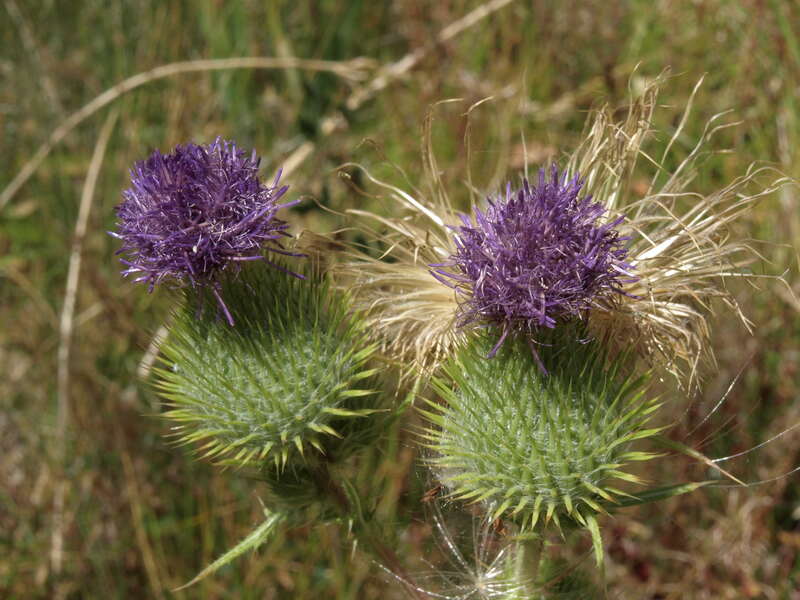
Photo Credit: Jim Morefield / Flickr / CC BY-SA 2.0
Known for having prickly spines covering its stem, leaves, and purple-pink flower head, bull thistle is one of the most noxious weeds in Atlanta that can injure both humans and animals. It can grow and spread quickly, crowding out desirable plants. This tall broadleaf weed typically grows in grassy areas and can grow up to 7 feet tall.
This biennial plant grows in the second year after germination. It can spread through wind-blown seeds or by root fragments, making it a difficult weed to control once it becomes established. It’s also a prolific seed producer, with each invasive plant producing up to 10,000 seeds that remain viable in the soil for years.
Bull thistle has a long taproot, so it can be difficult to control and completely eradicate once established. You can prevent this invasive weed from spreading by performing proper lawn maintenance and regular weeding.
Plant type: Biennial broadleaf weed
USDA hardiness zone: 3-10
Habitat: Moist to dry, adaptable to many soil types
Danger: Can be harmful to humans and animals due to sharp spines, some species are toxic
Removal method: Hand-pulling is an option for small infestations, but post-emergent herbicides may be necessary for larger areas. Due to its sharp spines, remember to wear protective gloves and clothing when handling bull thistle.
3. Common Chickweed (Stellaria media)
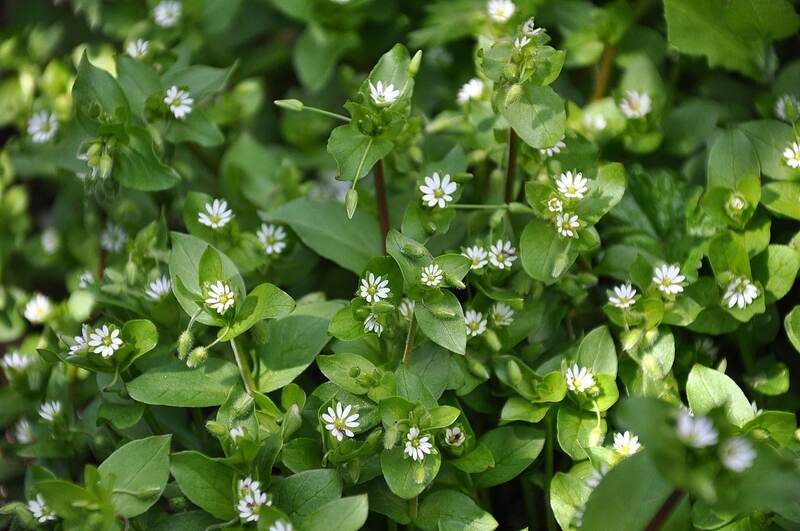
Photo Credit: Lazaregagnidze / Wikimedia Commons / CC BY-SA 4.0
Common chickweed is a pervasive weed in Atlanta and one of the worst offenders for gardeners and lawn enthusiasts. This common winter annual weed grows during the cooler months, making it difficult to control in the fall and early spring.
To identify common chickweed, look for its characteristic small white flowers with deeply lobed petals and pointed, oval leaves that are arranged oppositely along its stem. It can grow up to 8 inches tall and forms a dense mat on the ground, often outcompeting grass and other desirable plants in lawns and gardens.
This lawn weed grows in a variety of soil types and is often found in disturbed areas such as lawns, gardens, and fields. It spreads quickly by seed – a single plant can produce up to 15,000 seeds per year.
Prevention is key to controlling this weed. Maintaining a healthy lawn or garden with good soil health, regular watering, and proper fertilization can help prevent its growth.
Plant type: Annual cool-season broadleaf weed
USDA hardiness zone: 4-11
Habitat: Moist to mesic conditions
Danger: The saponins in its leaves are toxic but are usually broken down with cooking. Plus, they would just pass through the body without causing harm.
Removal method: Hand-pulling or hoeing is effective if done early in the season before the plants have produced seeds. Applying pre-emergent herbicides specifically formulated for broadleaf weed control also can be effective.
4. Crabgrass (Digitaria sanguinalis)
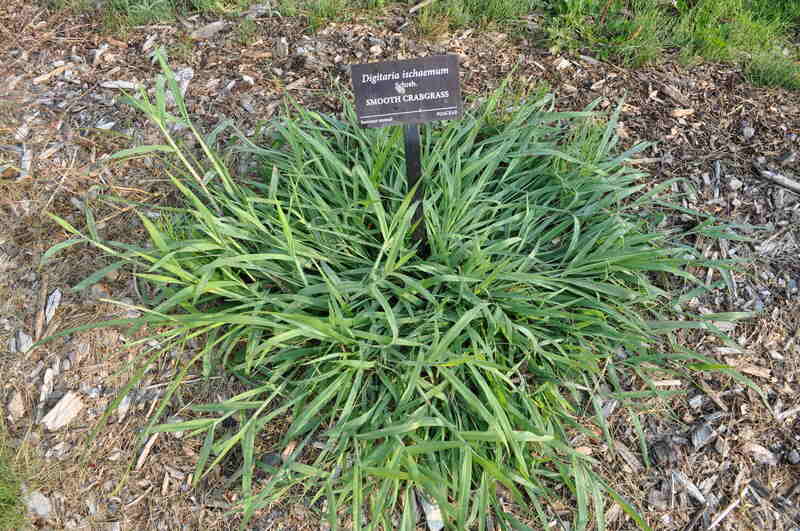
Photo Credit: NY State IPM Program at Cornell University / Flickr / CC BY 2.0
An annual warm-season grass weed that grows aggressively during the warm months in Atlanta, crabgrass can quickly take over a lawn. It typically starts to sprout in late spring and continues to grow throughout the summer. The plant will start to die off in the fall when temperatures cool.
Identifying crabgrass is relatively easy – just look for the star-shaped pattern of the leaves and the clumping growth habit. Its long, flat leaves are light green in color and spread out from the stem in a star pattern. It can grow up to 2 feet tall and has small, greenish-purple flowers that bloom in the summer.
Often found in lawns with poor soil health or mowed too short, crabgrass typically grows in thin or bare areas where there’s disturbed soil, such as along the edges of driveways or sidewalks. Preventing crabgrass involves maintaining a healthy lawn and soil. This includes regular fertilization, proper watering, and maintaining a healthy grass height.
Plant type: Annual warm-season grass weed
USDA hardiness zone: 3-11
Habitat: Thin spots, disturbed and dry soil
Danger: Non-toxic to humans and animals, but its natural pesticide can kill other plants near it
Removal method: One option is to use a pre-emergent herbicide in the spring before the weed has a chance to germinate. Another option is to remove the weed manually by hand or with a hoe (remove the entire plant, including the root system, to prevent regrowth.)
5. Dandelion (Taraxacum officinale)

Photo Credit: Pixabay
Dandelions are a common sight in Atlanta, and they are one of the worst lawn weeds due to their prolific and persistent nature. These perennial weeds are known for their yellow flowers and deeply serrated leaves, which can grow up to 12 inches long. Dandelions can quickly spread throughout lawns, flower beds, gardens, and fields, making them difficult to control and eliminate.
With a long, thick taproot that can extend up to 10 inches into the soil, their leaves grow in a rosette formation close to the ground. The bright yellow flowers resemble miniature suns, with numerous petals radiating outward from a central yellow disc. Once the flowers have bloomed, they develop into spherical seed heads known as “blowballs,” which disperse seeds with the slightest breeze.
Dandelions can grow in a variety of grasses, including fescue, bluegrass, and ryegrass. They typically begin growing in early spring and continue to thrive throughout the summer and fall. Dandelions thrive in nutrient-rich soil and can quickly take over lawns and gardens that are not adequately maintained.
Plant type: Perennial broadleaf weed
USDA hardiness zone: 3-10
Habitat: Nutrient-rich soil
Danger: Low, may cause skin irritation or contact dermatitis after exposure to its sap
Removal method: Use a post-emergent herbicide specifically formulated for broadleaf weed control. Regular mowing and proper irrigation can help keep lawns healthy and prevent weed growth.
6. Henbit (Lamium amplexicaule)
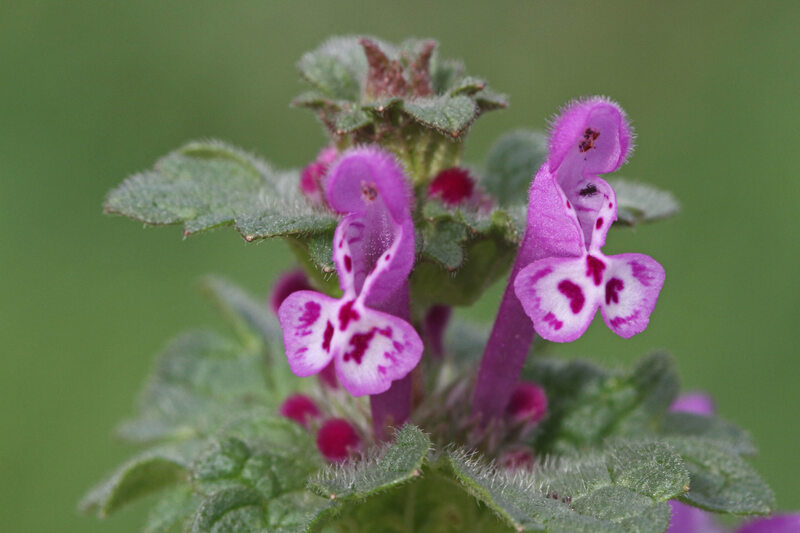
Photo Credit: Miltos Gikas / Flickr / CC BY 2.0
One of the most common and invasive weeds in Atlanta, henbit is an annual broadleaf weed that can quickly spread throughout lawns and gardens and is often difficult to control.
Henbit typically grows up to 12 inches tall, with rounded, deeply lobed, and coarsely toothed leaves. The leaves are typically a dull green but can have a purplish tint. The plant also produces pink to purple flowers, which bloom from March to June.
Often found in lawns, gardens, and along roadsides, henbit grows during the cooler months – from fall to spring. Various factors cause its growth, including poor lawn maintenance, soil compaction, and over-watering. To prevent henbit, maintain a healthy lawn by regularly fertilizing, mowing, and minimizing soil compaction.
Note that henbit can attract pollinators such as bees and butterflies, so consider leaving some in less visible areas of your lawn or garden.
Plant type: Annual cool-season broadleaf weed
USDA hardiness zone: 3-8
Habitat: Prefers moist and fertile soils, but can grow in a variety of soil types
Danger: Non-toxic to humans and animals
Removal method: Pre-emergent weed control in the fall can help prevent its growth. Hand-pull when it’s still young and hasn’t produced flowers or seeds.
7. White Clover (Trifolium repens)
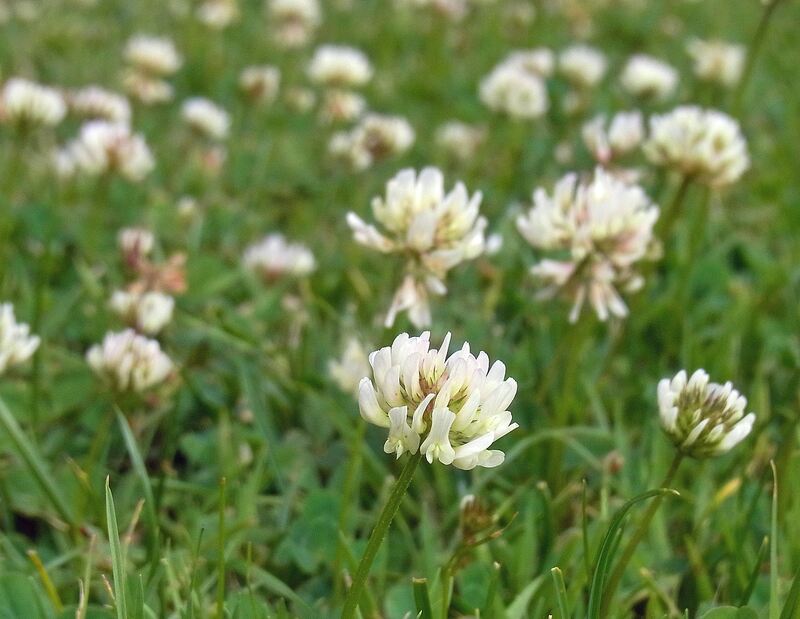
Photo Credit: Lawn Weeds / Wikimedia Commons / CC BY 2.0
White clover has aggressive growth habits and can compete with grass for nutrients and moisture. It’s a low-growing perennial plant that produces white or pinkish flowers and thrives in moist, nutrient-rich soil. While it’s often used as a groundcover in gardens, white clover can quickly overtake a lawn, forming dense mats that suffocate the grass and cause brown spots.
To identify white clover, look for its characteristic three-lobed leaves with white or pink flowers that bloom from late spring to early fall. It spreads through horizontal stolons that creep along the ground and root at intervals.
White clover can be beneficial in gardens, as it attracts pollinators and fixes nitrogen in the soil. However, it is considered a weed in lawns and should be controlled.
Most commonly found in poorly maintained lawns or inadequate nitrogen fertilization, it grows in most grasses and can thrive in a variety of soil types. To prevent white clover from taking over a lawn, maintain a healthy turfgrass by regular mowing, watering, and fertilization. Ensuring adequate nitrogen levels in the soil also can help discourage clover growth.
Plant type: Perennial broadleaf weed
USDA hardiness zone: 3-10
Habitat: Well-aerated, nutrient-rich soil like loam or clay
Danger: When its leaf tissues get damaged, white clover emits a noxious substance – cyanide.
Removal method: For small infestations, clover can be removed by hand, ensuring that the entire root system is extracted. Broadleaf herbicides can effectively kill clover without harming the grass. Apply them according to the instructions on the label. If you don’t want to use chemical herbicides, you can apply corn gluten meal or vinegar solutions.
8. Yellow Nutsedge (Cyperus esculentus)
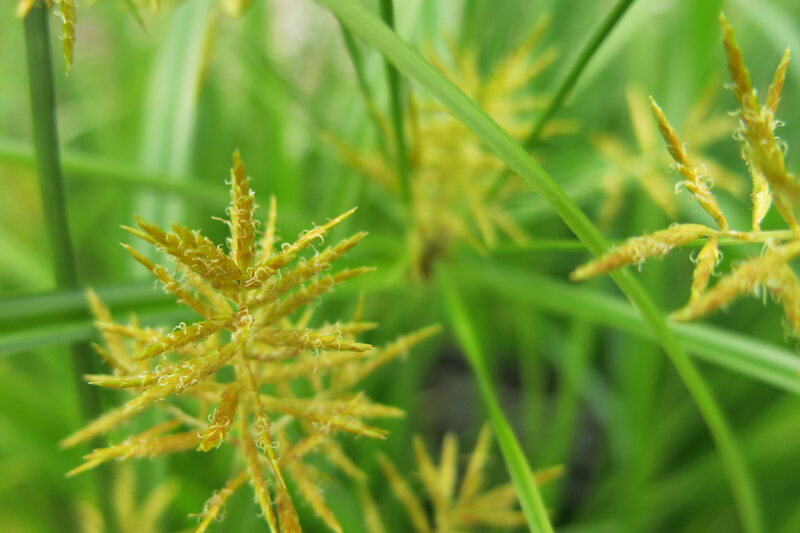
Photo Credit: NY State IPM Program at Cornell University / Flickr / CC BY 2.0
Also known as yellow nutgrass, yellow nutsedge is aggressive and can quickly overtake lawns, gardens, and agricultural fields. It grows during the summer months – from late May through September. Spreading through underground tubers and quickly multiplying throughout the soil, this weed will compete with other plants for resources, making it difficult to maintain healthy plant growth.
Yellow nutsedge is a perennial weed with a distinctive yellow-green color and triangular stem that grows to around 2-3 feet tall. It has long, narrow leaves that emerge from the base of the plant and a small, cone-shaped flower head that appears in the summer. It can be easily confused with other grassy weeds, but the triangular stem is a key identifying feature.
This sedge weed typically grows in warm-season grasses, including bermudagrass and Zoysiagrass. Preventing its growth can be challenging, but maintaining good soil drainage, regular mowing, and proper fertilization can help keep it at bay.
Plant type: Perennial sedge weed
USDA hardiness zone: 8-10
Habitat: Moist, poorly-drained soil or areas with standing water
Danger: Non-toxic to humans and animals
Removal method: Dig up and remove tubers or apply post-emergent herbicides (be careful with your application to avoid damaging desirable plants)
FAQ About the Worst Weeds in Atlanta
The answer is yes, it can. However, its effectiveness may not be as potent as regular weed killers. Vinegar works by killing the green parts of the plant on contact, but it won’t eliminate the root. So, while vinegar may be a natural option for dealing with a few weeds, it may not be the best choice for getting rid of a larger infestation.
Selective herbicides target specific types of plants while leaving other plants unharmed. They are often used in lawn care and agriculture to control weeds without damaging desirable plants or crops.
They work by targeting specific enzymes or metabolic processes unique to certain types of plants. For example, broadleaf herbicides are a type of selective herbicide that target broadleaf weeds while leaving grasses unharmed. Grasses have a different type of metabolism than broadleaf plants, and the herbicide is designed to target specific enzymes that are present in broadleaf plants but not in grasses.
Selective herbicides are useful for controlling weeds in areas where non-target plants are present. They can be applied as a spot treatment or broadcast over a large area. But remember to follow the label instructions carefully and use caution when applying selective herbicides, as they can still have negative impacts on the environment and non-target plants if used improperly.
Non-selective herbicides work by killing or damaging any plant they come into contact with, regardless of the plant species or variety. They do this by disrupting important metabolic processes in the plant, such as photosynthesis or protein synthesis, which ultimately leads to the plant’s death.
The active ingredients in non-selective herbicides can vary, but they are typically broad-spectrum and highly effective at killing plants. Some common active ingredients in non-selective herbicides include glyphosate, glufosinate, and paraquat.
Non-selective herbicides are typically used in situations where all vegetation needs to be removed. However, their non-specific nature means they also can harm non-target plants and should be used cautiously.
Professional Weed Control for Your Atlanta Landscape
While weeds may seem like an insurmountable problem in Atlanta, there are many effective ways to combat them. By identifying the eight worst offenders and implementing the strategies outlined above, homeowners and gardeners can take control of their outdoor spaces and enjoy a weed-free lawn and garden.
Remember, a healthy lawn is your best defense against weeds, so fertilize and water regularly. And if it doesn’t work, don’t be afraid to get your hands dirty and pull weeds out by the roots. With a little persistence and some expert guidance, a beautiful, weed-free yard is within reach.
For more information on weed control and lawn care, reach out to an Atlanta lawn care pro near you.
Main Image Credit: Pxhere